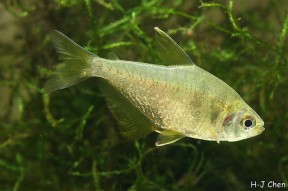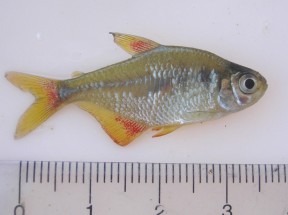Hyphessobrycon bifasciatus
Yellow Tetra
Etymology
Hyphessobrycon: from the Ancient Greek υπελάσσων (hyphesson), meaning ‘of lesser stature’, and used as a prefix in this case, plus the generic name Brycon.
bifasciatus: from the Latin bis, meaning ‘twice’, and fasciatus, meaning ‘banded’, in reference to the two dark bars on tyhe anterior portion of the body.
Classification
Order: Characiformes Family: Characidae
Distribution
Native to coastal river systems of southeastern Brazil between the states of Espírito Santo and Rio Grande do Sul, plus parts of the upper Paraná basin.
Type locality is ‘Rio Parahyba at Campos, Brazil’.
Habitat
Floodplain tributaries, lakes and streams, usually under forest cover.
Maximum Standard Length
40 – 45 mm.
Water Conditions
Temperature: 20 – 25 °C
pH: 5.0 – 7.5
Hardness: 36 – 268 ppm
Diet
Likely an opportunistic omnivore by nature feeding on aquatic invertebrates, fallen fruit and suchlike.
In the aquarium it’s easily-fed but the best condition and colours offer regular meals of small live and frozen foods such as bloodworm, Daphnia, and Artemia alongside good quality dried flakes and granules, at least some of which should include additional plant or algal content.
Behaviour and CompatibilityTop ↑
Generally peaceful making it an ideal resident of the well-researched community aquarium.
It’s perhaps best-maintained alongside similarly-sized characids, gasteropelecids, lebiasinids, smaller callichthyid or loricariid catfishes and non-predatory, medium-sized cichlids.
Try to buy a mixed-sex group of at least 8-10 specimens, include other schooling fishes to provide security, and you’ll be rewarded with a more natural-looking spectacle.
Sexual Dimorphism
Adult males are slightly more intensely-coloured when in good condition while females tend to grow a little larger and be rounder in shape, especially when gravid.
Reproduction
Egg-scatterer exhibiting no parental care.
NotesTop ↑
This species is susceptible to an affliction that has been observed in a number of small characiform species, which causes some or all of the body scales to appear metallic gold in colour. It remains unclear whether this is a consequence of a parasitic infestation, as has been suggested, but affected fish appear to be in no discomfort and their lifespan and overall health seem undiminished.
It can be distinguished from similar congeners by the following combination of characters: presence of two well-defined, vertically elongate humeral spots, the anterior of which is most prominent; absence of blotch on caudal peduncle; distal border of anal-fin slightly convex to straight, with no distinct anterior lobe in males, but posteriormost unbranched ray and first to second branched rays shorter than subsequent branched rays; absence of elongated, filamentous dorsal fin in adult males; presence of hooks on anal-fin in mature males; usually 34 longitudinal scales; 27-32 branched anal-fin rays; 1-2 maxillary teeth; maxilla broad and moderately long; premaxillary teeth tetra- to pentacuspid.
Hyphessobrycon was raised by Durbin in Eigenmann (1908) as a subgenus of Hemigrammus, differing from the latter by the absence of scales on the caudal-fin.
The grouping was revised by Eigenmann (1918, 1921) while Géry (1977) created artificial groups of species based on colour pattern, and these definitions are still widely used today, e.g., the H. agulha group, the H. heterohabdus group, etc. These cannot be considered to represent monophyletic assemblages, however, and their concepts continue to be redefined.
Weitzman & Palmer (1997) hypothesised the existence of a monophyletic assemblage within the genus based on colour pattern and male fin morphology that they termed the ‘rosy tetra clade’, with one of the characters supporting its monophyly being presence of a prominent dark marking on the dorsal-fin. This assemblage, plus other morphologically similar species, is considered to represent Hyphessobrycon sensu stricto by some authors, with the remaining species included in a much-expanded H. heterohabdus group.
Others have proposed conflicting, typically more restricted, views of both the genus and/or its constituent species groups, and significant confusion remains. What is clear is that, as currently recognised, Hyphessobrycon is a polyphyletic lineage containing several genera.
The process of splitting it up has already started, and Malabarba et al. (2012) revalidated the genus Ectrepopterus Fowler, previously considered a synonym of Hyphessobrycon. They also analysed its relationships within the Characidae in the context of Mirande’s (2010) previous work, but included the type species, H. compressus, for the first time in such a study. The results demonstrated that H. compressus is more closely-related to ‘rosy tetra’ representatives such as H. eques, H. pulchripinnis, and H. socolofi than other members of the genus including H. anisitsi, H. bifasciatus, H. elachys, H. herbertaxelrodi, and H. luetkeni.
References
- Ellis, M. D., 1911 - Annals of the Carnegie Museum v. 8 (no. 1, art. 2): 148-163
On the species of Hasemania, Hyphessobrycon, and Hemigrammus collected by J. D. Haseman for the Carnegie Museum. - Calcagnotto, D., S. A. Schaefer, and R. DeSalle, 2005 - Molecular Phylogenetics and Evolution 36(1): 135-153
Relationships among characiform fishes inferred from analysis of nuclear and mitochondrial gene sequences. - Carvalho, F. R., G. C. de Jesus and F. Langeani , 2014 - Neotropical Ichthyology 12(2): 247-256
Redescription of Hyphessobrycon flammeus Myers, 1924 (Ostariophysi: Characidae), a threatened species from Brazil. - Géry, J., 1977 - T. F. H. Publications, Inc.: 1-672
Characoids of the world. - Malabarba, L. R., V. A. Bertaco, F. R. Carvalho & T. O. Litz., 2012 - Zootaxa 3204: 47-60
Revalidation of the genus Ectrepopterus Fowler (Teleostei: Characiformes), with the redescription of its type species, E. uruguayensis. - Mirande, J. M., 2010 - Neotropical Ichthyology 8(3): 385-568
Phylogeny of the family Characidae (Teleostei: Characiformes): from characters to taxonomy. - Oliveira, C. A., G. S. Avellino, K. T. Abe, T. C. Mariguela, R. C. Benine, G. Orti, R. P. Vari, and R. M. Corrêa e Castro, 2011 - BMC Evolutionary Biology 11(1): 275-300
Phylogenetic relationships within the speciose family Characidae (Teleostei: Ostariophysi: Characiformes) based on multilocus analysis and extensive ingroup sampling. - Reis, R. E., S. O. Kullander and C. J. Ferraris, Jr. (eds), 2003 - EDIPUCRS, Porto Alegre: i-xi + 1-729
Check list of the freshwater fishes of South and Central America. CLOFFSCA. - Teixeira, T. F., F. C. T. Lima and J. Zuanon, 2013 - Copeia 2013(4): 612-621
A new Hyphessobrycon Durbin from the Rio Teles Pires, Rio Tapajós Basin, Mato Grosso State, Brazil (Characiformes: Characidae). - Weitzman, S. H. and L. Palmer, 1997 - Ichthyological Exploration of Freshwaters 7(3): 209-242
A new species of Hyphessobrycon (Teleostei: Characidae) from the Neblina region of Venezuela and Brazil, with comments on the putative `rosy tetra clade'. - Zarske, A., 2014 - Vertebrate Zoology 64(2): 139-167
Zur Systematik einiger Blutsalmler oder "Rosy Tetras" (Teleostei: Ostariophysi: Characidae).




